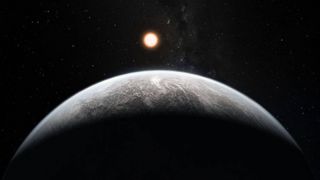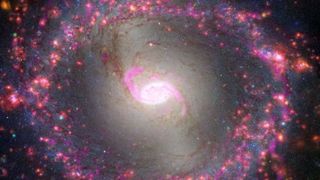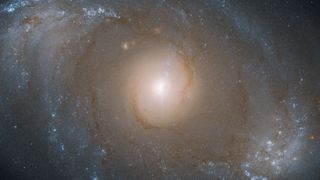What’s on the James Webb Space Telescope’s ‘to do’ list?
Webb is going to have a very busy first year

NASA's James Webb Space Telescope is about to reach its new home.
The most advanced space observatory ever constructed, the James Webb Space Telescope (JWST), will reach Earth's second Lagrange point (L2) at 2:00PM EST on Monday, January 24, 2022. It’s a special place in space a million miles behind Earth from where it can keep the Sun, Earth and Moon behind it as it looks deep into the cosmos like never before.
Then what?
Webb is not due to start science operations until later this year, probably around May or June 2022 when the 18 gold-covered beryllium segments of its iconic 21.5-foot/6.5-meter mirror have been aligned and its optical system calibrated.
Specializing in detecting the oldest light in the Universe–the infrared part of the spectrum–we know Webb will photograph the first galaxies, explore the mysteries of the origins of the Universe and directly image exoplanets, but what’s actually on its official to-do list?
From a long-list of over 1,100 projects from 44 countries, here are some of the most intriguing projects already allotted time–8,760 hours in total–on Cycle 1, Webb’s first year of planned observations.
Look for the ‘cosmic dawn’

The first and biggest project in Webb’s first year will be COSMOS-Webb, a program to map the earliest galaxies in the universe – the so-called ‘cosmic dawn.
Get daily insight, inspiration and deals in your inbox
Get the hottest deals available in your inbox plus news, reviews, opinion, analysis and more from the TechRadar team.
This is likely to produce data used by scientists for decades. Its NIRCam instrument will point at the same reference area of the night sky as previously imaged by Hubble, but this time should reveal half-a-million as-yet-unseen galaxies in the near-infrared as well as 32,000 galaxies in the mid-infrared.
“Because we’re covering such a large area, we can look at large-scale structures at the dawn of galaxy formation,” said Caitlin Casey, an assistant professor at the University of Texas at Austin and co-leader of the COSMOS-Webb program. “We will also look for some of the rarest galaxies that existed early on, as well as map the large-scale dark matter distribution of galaxies out to very early times.”
COSMOS-Webb is part of the Webb Treasury program, which are datasets that are considered to be so important that they will be made publicly available in perpetuity.
See if the TRAPPIST-1 System contains an Earth 2.0

Webb will soon make the first detailed near-infrared study of the atmosphere of a habitable-zone planet.
About 41 light years from Earth, in the constellation of Aquarius, TRAPPIST-1 is a small red dwarf star with seven Earth-sized planets around it – the most we know of so far. Three exoplanets were found around TRAPPIST-1 in 2016 by the Transiting Planets and Planetesimals Small Telescope (TRAPPIST) in Chile, then more by NASA’s now-retired Spitzer Space Telescope.
Now it’s Webb’s turn to tell us something we don’t know about these possibly Earth-like planets – in particular TRAPPIST-1c, which is thought to be rocky and Venus-like.
In Webb’s first year it will produce data for Hot Take on a Cool World: Does Trappist-1c Have an Atmosphere? and Probing the Terrestrial Planet TRAPPIST-1c for the Presence of an Atmosphere.
Another project, Atmospheric reconnaissance of the TRAPPIST-1 planets, will confirm if the planets have atmospheres.
Unravel the mysteries of star formation

How do stars and star clusters form? You might think astronomers should know that by now, but much of the universe is obscured by gas and dust.
Cue Webb, which will be able to see through all that thanks to its infrared sensitivity. So in another of the Webb Treasury studies, an international research team will survey the stars, star clusters, and dust that lie within 19 nearby galaxies.
It’s called the PHANGS (Physics at High Angular resolution in Nearby GalaxieS) Survey and it brings together over 100 international experts to study star formation from beginning to end.
“Webb will reveal star formation at its very earliest stages, right when gas collapses to form stars and heats up the surrounding dust,” said Janice Lee, Gemini Observatory chief scientist at the National Science Foundation’s NOIRLab in Tucson, Arizona.
It should create revolutionary data and spur major scientific advances, according to the scientists.
Reveal the moons of Uranus

Save for a brief flyby in 1986 by NASA’s Voyager 2 probe, the seventh planet from the Sun is virtually unexplored, and its 27 moons even less so.
That's where The Moons of Uranus: A NIRSpec Investigation of Their Origins, Organic Constituents, and Possible Ocean World Activity comes in, a project that will use 21 hours of Webb’s time to study Ariel, Umbriel, Titania and Oberon.
These four largest moons will be examined for traces of ammonia, organic molecules, carbon dioxide ice, and water to see if they do, as theorized by some, host underground oceans.
It’s hoped that the dataset might be used to help plan future spacecraft missions to explore Uranus and its moons, such as this exciting new flagship mission currently being discussed by NASA.
Weigh a supermassive black hole

Astronomers have found a supermassive hole weighing about 40 million times as much as our Sun in a nearby spiral galaxy called NGC 4151.
In an effort to work out exactly how a supermassive hole (which are present in all galaxies) ‘feeds’ and affects the surrounding galaxy, a team led by the University of Memphis wants to use Webb to determine its mass.
In AGN Feeding and Feedback in NGC 4151 Webb will be used to measure the motions of stars in the galaxy’s core, since the faster nearby stars will move the heavier the black hole must be because its gravitational influence is increased.
How Webb will make its discoveries
To understand why Webb is unique and how it will make its discoveries, it helps to know exactly what scientific instruments are on board:
MIRI (Mid-Infrared Instrument): a camera and a spectrograph that sees light in the mid-infrared region of the electromagnetic spectrum. Primarily for better-than-Hubble wide-field astrophotography images.
NIRCam (Near Infrared Camera): to detect light from the earliest stars and galaxies. It has a coronagraph so it can block a star’s light, which helps in the search for planets orbiting nearby stars.
NIRISS (Near Infrared Imager and Slitless Spectrograph): for ‘first light’ detection of the first stars, and for detecting exoplanets as they cross their star.
NIRSpec (Near InfraRed Spectrograph): a spectrometer to disperse light from an object into a spectrum. This instrument can observe 100 objects simultaneously.
Jamie is a freelance tech, travel and space journalist based in the UK. He’s been writing regularly for Techradar since it was launched in 2008 and also writes regularly for Forbes, The Telegraph, the South China Morning Post, Sky & Telescope and the Sky At Night magazine as well as other Future titles T3, Digital Camera World, All About Space and Space.com. He also edits two of his own websites, TravGear.com and WhenIsTheNextEclipse.com that reflect his obsession with travel gear and solar eclipse travel. He is the author of A Stargazing Program For Beginners (Springer, 2015),

